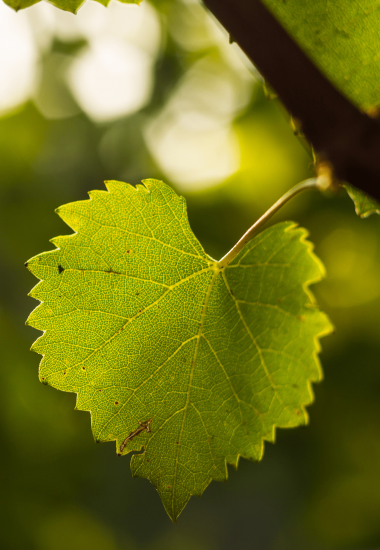
Terroir & Vineyard
From atop Mont Brouilly, you have to descend into the valley to get to the semi-circular vineyard surrounding the castle. The domain’s 70 hectares of vines flourish in the middle of the Beaujolais countryside, 40 of which are in Les Tours. A landscape rich in flora and fauna, dotted with rivers and wet meadows, surrounds it. The moors are dominated by genista. The woods welcome roe deer, eagles, and mushrooms. The quarries are home to eagle owls and bats.

-
The les Tours microclimate
The estate's vineyard benefits from its own microclimate, close to semi-continental with Mediterranean influences.
Cold winters limit the activity of many harmful species and promote hardening, thus also protecting the vines from winter frosts. Over the seasons, temperatures rise. We then pay special attention to the spring frost and hailstorms, which constitute a real danger for the vineyard. The summers are hot and sunny, an asset for the grapes' ripening as well as controlling pests. Thanks to the rains drained by the sandy soils, the vine receives the right amount of water necessary for its development throughout the year. Fantastic news for the concentration of the berries!
-
A unique wine country
At 328 meters above sea level, the vineyard enjoys great southern/south-eastern sun exposure. The sand, which heats up quickly, diffuses this heat and helps the vines grow and the grapes ripen.
The poor, acidic, and shallow soils produce firmer and better-balanced berries than in richer soils. The aromas and flavors are more intense. Although brittle on the surface, the subsoil is compact with crystalline rock (gneiss, diorite, granite, and shale). As it breaks down, the shale releases minerals like iron, potassium, and magnesium that give the wine its specific character.
-
Gamay - a royal grape variety
Gamay has its roots in 17th century Beaujolais. The only variety of the Brouilly cru, it thrives on the estate’s granite soils.
In its velvety and supple casing, its scents are fruity and spicy, imbued with elegance and modernity. Our oldest vines, some planted over 80 years ago, give a richer and more concentrated interpretation.

A Philosophy Focused on the Environment
Everything here exudes respect for nature and its biodiversity. Our goal is to preserve the terroir and grow healthy vines and berries.

It starts with viticulture that respects the environment, obtaining environmental certifications from Terra Vitis (2019) and HVE3 (2020). Regarding Terra Vitis, protecting natural resources is a priority to promote soil life and allow the vines to protect themselves naturally. It is a philosophy committed to the three pillars of sustainable development: environmental, social, and economic.
As for HVE3, the management of the farm integrates and develops biodiversity and promotes autonomous agriculture that does not degrade the soil, water, and air.

In this sense, many plots are kept grassy, keeping the soil alive. Thrushes, hares, rabbits, and partridges can therefore wander between the rows of vines and enjoy the vegetation. Also, we use trellising more often, offering the bunches good ventilation and better exposure to the sun. The ripening of the berries is thus optimized!



